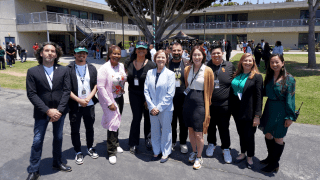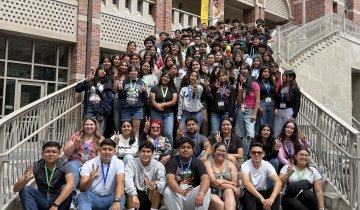On May 29, 421 students at Cabrillo High School, located within the Long Beach Unified School District (LBUSD), celebrated Decision Day, an opportunity to recognize a students’ post-high school plans–whether that be a two- or four-year college, workforce or military service. From day one of the students’ senior year to this moment, Monique Bravo and Sebastian Ramirez, USC College Advisory Corps (USC CAC) advisers, worked with each student.
Bravo and Ramirez ensured that they met with students throughout their senior year. Each student’s post-high school intentions were unique, with some not initially considering college, according to Bravo. Taking the time to have the college conversation was the first step for these students. “Now they’re applying to different community colleges and thinking, ‘okay, well, I didn’t want that at the beginning, but now that I’ve had these conversations, I know it’s a possibility.’”
According to LBUSD Superintendent Jill Baker EdD ’04 who attended the Cabrillo High event, the fourth largest district in California focuses on early literacy, acceleration in the middle grades, and college and career readiness. “The USC CAC program has been instrumental in guiding students to make the best choice for themselves,” Baker said. “It’s also a place where they get incredible support to complete their Free Application for Federal Student Aid (FAFSA) and to help navigate through all the financial aspects of getting to college.”
Post-high school decisions are equally exciting and daunting. Not only are USC CAC advisers there to provide students post-high school guidance, they assist with the college and financial aid application process. “There’s this moment where students go from ‘Oh, yay! I got into USC’ or ‘I got into UCLA’ to ‘Oh, no! What does this mean?,’” said Benjamin Robles, assistant program director with the USC CAC within the USC Rossier Center for Enrollment Research Policy and Practice (CERPP). With the recent changes to FAFSA, for some students the decision to attend college may rest on securing financial aid to support their educational goals.
“I think that most of the students did feel very supported during all the FAFSA complications,” said Bravo. She was consistent with checking in with students, letting them know what their options were and informing them of available resources, including the ability to appeal for financial aid. “Being there for the students was a very big part of it, and letting them know what information and resources could help them in these situations.” Of the students she worked with, approximately 94% successfully submitted their financial aid forms.
Leading up to Decision Day, the Cabrillo High School and USC CAC advisor partnership was key. Bravo and Ramirez working on campus and meeting students in person, assisted in establishing trust between teachers and students and creating a collaborative environment. In addition to CAC advisors having access to high school resources like space and school staff, school administration and leadership also had the opportunity to see student potential and the results of all their hard work.
As far as the college transition, many students had the skill set and were college-ready, according to Robles. Students already had the academic acumen and extracurricular activities on their high school transcripts. USC CAC advisors were there to help students over the last bridge, the college and financial aid applications. “The stakes are high…It’s really important to have resources there at a high school to support students,” Robles said. “We're really proud of the fact that so many high schools across Los Angeles trust us to be that resource, helping students through every aspect, from the college search and applying to securing financial aid and ultimately to enrolling.”
While there are similar college advising programs, USC CAC is not a federally funded program. USC CAC is not cohort-based, has advisers on-site five days a week and works with all students, not just high-achieving students. “It is really about unlocking the potential within so many communities here in Los Angeles, and giving them that opportunity to change the course of their lives through higher education,” Robles said.
Of the 421 students that Ramirez and Bravo advised, more than 350 are going to college/university. “I see students who had many struggles but never gave up,” Ramirez said. “I’m extremely happy to see what everyone has accomplished and to be able to give them a day where they can celebrate their decisions.”
Looking ahead, Decision Day at Cabrillo High School is a tradition that Bravo hopes only gets larger with each graduating class. She has already met with some of the juniors, sophomores and freshmen. Bravo added, “Whenever I can, I'm like, have you all thought about college?”




